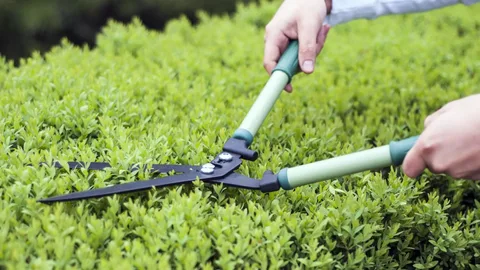What is Hedge Trimming? Keep Your Garden Looking Sharp!

Strong 8k brings an ultra-HD IPTV experience to your living room and your pocket.
What is Hedge Trimming?
Hedge trimming is the process of cutting and shaping hedges to maintain a neat and healthy appearance. It involves removing overgrown branches and leaves to encourage balanced growth and maintain structural form.
In practical terms, hedge trimming keeps your garden borders tidy and prevents shrubs from overshadowing paths, fences, or neighbouring properties. Regular trimming not only improves visual appeal but also enhances air circulation, reducing the risk of disease.
Top Tips for Trimming Hedges
Start by using sharp, clean tools to make precise cuts and reduce plant stress. Always trim your hedge so it's wider at the base than the top—this helps sunlight reach lower leaves evenly and prevents dieback. Here are our top six trimming tips to help you get it right:
1. Use the Right Tools
Choose the right tool for the job. Hand shears are perfect for shaping, while electric or petrol hedge trimmers offer speed and consistency. Always keep your blades sharp and clean to make smooth cuts and reduce the risk of spreading plant diseases between hedges.
2. Trim in Dry Weather
Avoid trimming on rainy or overly hot days. Damp leaves can cause blades to clog and increase the chance of fungal issues. Dry, overcast weather is best, as it reduces plant stress and makes cleanup easier while allowing for better visibility during trimming.
3. Shape from Bottom to Top
Start trimming at the bottom and work your way up to maintain better control. This technique gives you a more natural taper, keeps the hedge balanced, and allows lower leaves to receive enough sunlight for healthy growth, especially on dense or tall hedges.
4. Cut in Small Sections
Take your time and trim small layers rather than large chunks. This helps avoid uneven shapes and allows you to step back often and assess your progress. Cutting gradually ensures precision and keeps the overall appearance clean and professional-looking.
5. Check for Wildlife
Before you begin, inspect the hedge for active bird nests or small animals, especially during nesting season (March–August). Trimming a hedge with nesting birds is not only unethical but also illegal in the UK. Delay your work if you spot any signs of wildlife.
6. Clear Debris After Trimming
After trimming, always clear up the clippings around the base of your hedge. This prevents moisture build-up, rot, and pests. A tidy garden also helps the hedge breathe and makes future maintenance easier and cleaner.
Professional Hedge Trimming Services in Poole
If you lack time, tools, or confidence, it’s best to hire professionals. Expert hedge trimming services in Poole, like those offered by Tree Rebral, ensure precision, safety, and tailored care for each hedge species.
Our team understands local hedge types and seasonal growth patterns. We handle everything from tall boundary hedges to formal box hedging. You’ll save time, avoid injury, and get stunning results that truly elevate your outdoor space.
What Tools Do You Need to Trim a Hedge?
To get started, you’ll need a few essentials: hand shears, hedge trimmers (manual, electric or petrol), protective gloves, safety goggles, and a sturdy ladder if dealing with taller hedges.
Electric trimmers are ideal for speed and consistency, while manual tools are perfect for detail work. Don't forget to clean your blades after use to prevent the spread of plant diseases.
What Are the Benefits of Trimming Hedges?
Trimming hedges is more than just garden tidying—it’s about keeping your outdoor space healthy, stylish, and well-maintained. Below are some of the key benefits you’ll notice when you stay on top of your hedge trimming routine:
1. Encourages Healthy Growth
Regular trimming removes weak or overcrowded branches, allowing better airflow and light penetration. This strengthens the plant from within and encourages fresh, even growth. A well-trimmed hedge is less likely to suffer from disease or become patchy over time.
2. Prevents Pests and Diseases
Overgrown hedges can harbour pests and trap moisture, creating the perfect environment for fungal diseases. Trimming helps remove these problem areas, keeping your hedge clean and dry. This simple maintenance step plays a huge role in preventing long-term health issues.
3. Improves Garden Appearance
Neat, well-shaped hedges instantly upgrade the look of your garden. Whether framing a pathway or outlining your property, a trimmed hedge gives a polished, tidy appearance. It adds structure and helps the rest of your plants and features stand out.
4. Increases Property Value
Curb appeal matters—especially if you're thinking of selling. A smartly trimmed hedge suggests a well-cared-for home and garden. It adds visual appeal and can subtly raise the overall value of your property, making a great first impression on buyers.
5. Defines Boundaries Clearly
A trimmed hedge acts as a clear, natural boundary between properties or garden zones. It creates privacy, adds structure, and helps keep the layout of your outdoor space well-organised without the need for harsh fencing or artificial dividers.
6. Makes Future Maintenance Easier
Consistent trimming means you never have to deal with a wildly overgrown hedge again. Keeping it in shape regularly reduces workload over time and helps maintain the desired size and style without needing drastic cutting back.
When is the Best Time to Trim a Hedge?
The best time for hedge trimming depends on the type of hedge. For evergreen hedges, late spring or early summer is ideal. For deciduous varieties, wait until late winter or early spring before new growth starts.
Avoid trimming during active bird nesting seasons (March to August) to comply with UK wildlife protection laws. Winter trimming can also be effective if the weather is mild and dry.
How Often Should You Trim Hedges?
Fast-growing hedges like Leylandii may need trimming up to three times a year. Slower-growing varieties can usually be managed with one or two cuts annually.
Regular trimming keeps your hedge dense and healthy. It also saves you time in the long run by preventing excessive overgrowth and reducing the amount of material that needs to be cut back each time.
Why Choose Tree Rebral for Hedge Trimming in Poole?
At Tree Rebral, we bring nearly a decade of experience to every hedge trimming job in Poole and the surrounding areas. Our trained professionals handle each job with care, safety, and a keen eye for detail.
We don’t just cut—we assess your hedge health, growth pattern, and shape to deliver results that last. Whether it’s a once-a-year cut or regular maintenance, Tree Rebral ensures your garden stays sharp, stylish, and safe.
FAQs
When Is Hedge Trimming Season?
The main trimming season runs from March to September, but always check for nesting birds before trimming. For best results, follow the natural growth pattern of your hedge.
What’s The Best Time Of Year To Trim A Hedge?
Late spring and early summer are ideal. However, late winter is great for rejuvenating older hedges before new shoots arrive in spring.
Is There A Difference Between Trimming And Pruning?
Yes. Trimming focuses on shape and appearance, while pruning targets plant health—removing dead or diseased branches to encourage new growth.
Note: IndiBlogHub features both user-submitted and editorial content. We do not verify third-party contributions. Read our Disclaimer and Privacy Policyfor details.







